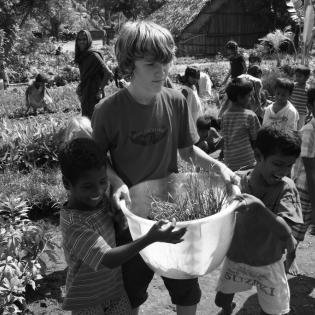To Repair the World: Methods and Me (Private-Religious)
In this lesson the learners will be introduced to some of the individuals/Heroes whose acts of tikun olam provide important models. Having developed a better understanding of tikun olam based upon Sefer Yetzirah and other classical and modern sources on the topic of how the work of tikun olam is to be performed, Lesson Three adds to the scaffolding necessary for learners to create their own mitzvah project/”service plan” for world repair.
The learner will:
- understand and explain the concept "hero".
- describe the work of selected mitzvah individuals/"heroes".
- describe and explain how ordinary people and ordinary objects can do the work of world repair.
- will select, learn about, and develop a mitzvah project/"service plan" to support the work of one of the individuals/"heroes" in the unit or create their own project based on the model.
- (Optional) will implement their mitzvah project/"service plan" of world repair and reflect on its effectiveness.
- Items associated with the stereotypical concept of heroism (i.e., sword, shield, superhero paraphernalia, etc.)
- Items that are reflective of the work of the heroic individuals profiled in this unit (a bagel, hair-cutting scissors/clip of hair, pair of shoes, teddy bear, duffel bag, etc.)
- Attachment One: Partners in Creation
- Attachment Two: I Can be a Partner In Creation: The Plan
- (Optional Service implimentation) Attachment Three: I Can Be a Partner in Creation: The Reflection
- Computers with internet access or print-outs of materials from the listed Internet sites (See Attachment One or Bibliography)
Should implementation of the designed mitzvah project/"service plan" be assigned, parent participation should be encouraged to assist the learner in completing this project. In addition, parents could be invited to a presentation of all projects and a celebration of their successful completion.
Research Internet Sites for individuals/mitzvah heroes:
Instructions
Anticipatory Set: Display the items associated with heroism in two areas of the classroom: one group the stereotypical "superhero" items, the other group, the items associated with some (or all) of the individuals whose work you have chosen to profile. Have the learners infer from the items in the first grouping what they might say about individuals who use those items. Have them compare and contrast the items in the second group with those in the first. Once this is completed tell the learners that the items in the second group are symbols of items used to perform mitzvot – commandments – which accomplish heroic work in our world. Holding each of these items up in turn, ask the learners to interpret their use in performing such deeds. ( i.e. How can a bagel (or scissors, etc.) be used to perform mitzvot?
Distribute a copy of Attachment One: Partners in Creation to each learner.
Provide computers with Internet access or print outs of the materials from the list in Attachment One: Partners in Creation or Bibliography.
Ask learners to determine which of the profiled individual's/hero’s work most appeals to them.Teacher Note: Be sure that each individual/hero is selected by at least one learner.
Have learners answer the questions and complete the chart entitled MITZVAH HERO and ME on Attachment One: Partners in Creation
Allow time for each learner to briefly share his/her chosen mitzvah hero and encourage the learners to make comparisons as they listen to each sharing. Conclude these brief presentations by asking the question: What have you learned from listening to these presentations about mitzvah heroes and your own ability to do mitzvah-work?Teacher Note: Assist the learners toward the realization ordinary people and ordinary objects can provide a “service” by doing the work of world repair.
Distribute Attachment Two: I Can be a Partner in Creation: The Plan and instruct the learners that they will now engage themselves in the development of a mitzvah project/"service plan" to assist one of the individuals/ heroes and/or the projects they represent.
(Optional) Have the learners implement their tikun olam project/"service plan" to assist one of the individuals/ heroes and/or the projects they represent and designate a completion date for this activity.
(Optional) Have the learners complete and hand in their mitzvah project/"service plan" reflection Attachment Three:I Can be a Partner in Creation: The Reflection.
Philanthropy Framework
-
Strand PHIL.I Definitions of Philanthropy
-
Standard DP 01. Define Philanthropy
-
Benchmark MS.4 Give examples of how individuals have helped others.
-
-
Standard DP 02. Roles of Government, Business, and Philanthropy
-
Benchmark MS.6 Identify significant contributions to society that come from the civil society sector.
-
-
Standard DP 06. Role of Family in Philanthropy
-
Benchmark MS.2 Discuss the function of family traditions and role modeling in teaching about sharing and giving.
-
-
-
Strand PHIL.II Philanthropy and Civil Society
-
Standard PCS 01. Self, citizenship, and society
-
Benchmark MS.4 Describe the characteristics of someone who helps others.
-
-
Standard PCS 03. Philanthropy and Economics
-
Benchmark MS.4 Give examples of how civil-society-sector giving can impact communities.
-
-
-
Strand PHIL.III Philanthropy and the Individual
-
Standard PI 01. Reasons for Individual Philanthropy
-
Benchmark MS.4 Identify and describe the actions of how citizens act for the common good.
-
Benchmark MS.5 Describe the responsibility students have to act in the civil society sector to improve the common good.
-
-
-
Strand PHIL.IV Volunteering and Service
-
Standard VS 02. Service and Learning
-
Benchmark MS.1 Select a service project based on interests, abilities and research.
-
-
Standard VS 03. Providing Service
-
Benchmark MS.1 Provide a needed service.
-
-
Standard VS 04. Raising Private Resources
-
Benchmark MS.3 Develop a service plan.
-
-
Standard VS 05. Integrating the Service Experience into Learning
-
Benchmark MS.2 Evaluate progress on the service-learning project before, during, and after the project.
-
-
